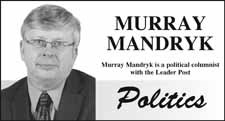There is no mistake rural Saskatchewan has been in a position of power and influence for the past seven years of Premier Brad Wall's government.
Saskatchewan Party MLAs representing all 29 rural seats and nearly two-thirds of the government caucus. Rural Saskatchewan hasn't enjoyed this much political representation since the 1960s when the rural population vastly outnumbered the urban population and city MLAs had no seats but were elected at large.
The same can said for Wall's cabinet that now has no representation from Prince Albert or Moose Jaw and only three MLAs from each Regina and Saskatoon. In fact, Saskatoon representation actually decreased to three ministers in the spring shuffle from four with both Rob Norris and Ken Cheveldayoff being dropped.
Moreover, rural ministers represent all the most influence portfolios included finance (Ken Krawetz), health (Dustin Duncan) energy and economic development (Bill Boyd), social services (Donna Harpauer), government relations (Jim Reiter), agriculture (Lyle Stewart) and, of course, the premier's office occupied by Wall.
About the only urban minister with a senior portfolio right now is Education and Labour Minister Don Morgan (although the justice ministry headed by Gord Wyant is often viewed as part of the senior ministry group).
Admittedly, this is less deliberate than it is the nature of the Sask. Party government. Coming into existence as a party that opposed the largely urban-based NDP, the Sask. Party's most senior and arguably most talented MLAs happen to come from the country. Really, would it make any sense to sit out a 15- or 20-year MLA who helped found the Sask. Party just to get every urban possible in cabinet?
But while this may be the reality of the Sask. Party's makeup, it's also done as much as it possible can to cater to rural needs.
Besides specific policies to reduce municipal/education taxes on agricultural land, increase highways spending and build rural hospital and nursing homes, Wall has even appointed a minister in charge of rural and remote health. That he would assign one minister to this task while asking another to handle both the massive departments of education and labour says much about the influence of rural issues on this government.
The very fact that this government choose to keep the numbers of rural seats the same - despite the on-going decline in rural population - also says much.
However, the slow march of that population shift from rural to urban in Saskatchewan (which, essentially, gains all three of the new seats the government will be adding) says even more.
And if one wants to gaze into the future, one need not look much further than the student enrolment statistics.
The official new numbers won't be out until later this month or early October, but expect a story very similar story to one we saw last year.
In 2013, student enrolment increased by 2,140 or 1.7 per cent to 170,582 students throughout Saskatchewan. More interesting, however, was that most of that increase was concentrated in the urban centres. Rural school enrolment continues to decline.
Sure, there are exceptions like the Estevan and Weyburn in the oil-booming south east or the bedroom communities around Regina and Saskatoon in particular.
But the most tell-tale statistics is that of the 28 school districts in the province last, only 17 experience an increase in enrolment, one had no change and 10 suffered declines.
At a time of population growth unseen in this province since the settlers flocked here for cheap agriculture land, that we so many rural schools are still losing kids tells us much.
And it reminds us is that there's no greater factor in political influence than population.
School enrolment numbers suggest these heady days of rural influence won't last forever.
Murray Mandryk has been covering provincial politics for over 22 years.




